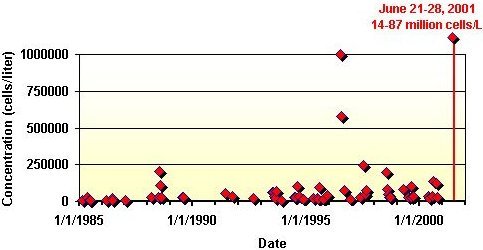|
July 11, 2001
Review of a Scrippsiella trochoidea bloom in the Patuxent River in late June 2001. |
|
The dinoflagellate Scrippsiella trochoidea was observed in record bloom densities by the Academy of Natural Sciences during late June. The bloom, which makes the water turn a red color, was observed in the lower Patuxent River in the tens of millions of cells per Liter between June 21 and June 28 (Figure 2). Figure 2. Long term
monitoring history for concentrations
Data from around the state suggest the species abundance and frequency of occurrence was generally increasing in 1990s but densities of the magnitude measured in late June on the lower Patuxent are unprecedented in the 18 year monitoring program. Since the bloom, densities for the species have declined at all monitoring stations in July. Scrippsiellas potential to cause adverse ecological effects needs further evaluation. Organisms forming this type of 'red tide' at such high densities can cause problems for finfish and shellfish because they may replace more nutritious algae, deplete oxygen, or clog gills affecting the ability of the fish to breathe. |

